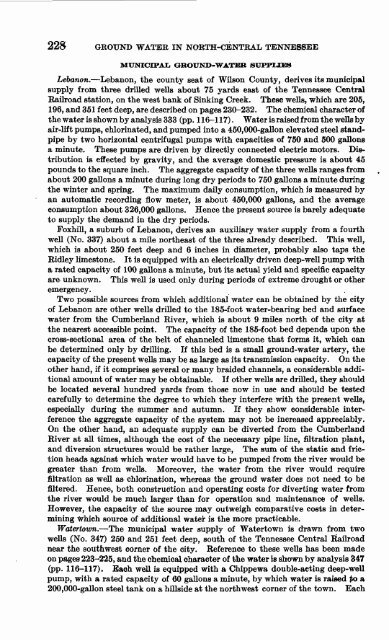GROUND WATER IN NORTH-CENTRAL TENNESSEE
GROUND WATER IN NORTH-CENTRAL TENNESSEE
GROUND WATER IN NORTH-CENTRAL TENNESSEE
You also want an ePaper? Increase the reach of your titles
YUMPU automatically turns print PDFs into web optimized ePapers that Google loves.
228 <strong>GROUND</strong> <strong>WATER</strong> <strong>IN</strong> <strong>NORTH</strong>-<strong>CENTRAL</strong> <strong>TENNESSEE</strong><br />
MUNICIPAL GBOUND-WATMR 8UPPUEES8<br />
Lebanon. Lebanon, the county seat of Wilson County, derives its municipal<br />
supply from three drilled wells about 75 yards east of the Tennessee Central<br />
Eailroad station, on the west bank of Sinking Creek. These wells, which are 205,<br />
196, and 351 feet deep, are described on pages 230-232. The chemical character of<br />
the water is shown by analysis 333 (pp. 116-117). Water is raised from the wells by<br />
air-lift pumps, chlorinated, and pumped into a 450,000-gallon elevated steel stand-<br />
pipe by two horizontal centrifugal pumps with capacities of 750 and 500 gallons<br />
a minute. These pumps are driven by directly connected electric motors. Dis<br />
tribution is effected by gravity, and the average domestic pressure is about 45<br />
pounds to the square inch. The aggregate capacity of the three wells ranges from<br />
about 200 gallons a minute during long dry periods to 750 gallons a minute during<br />
the winter and spring. The maximum daily consumption, which is measured by<br />
an automatic recording flow meter, is about 450,000 gallons, and the average<br />
consumption about 326,000 gallons. Hence the present source is barely adequate<br />
to supply the demand in the dry periods.<br />
Foxhill, a suburb of Lebanon, derives an auxiliary water supply from a fourth<br />
well (No. 337) about a mile northeast of the three already described. This well,<br />
which is about 250 feet deep and 6 inches in diameter, probably also taps the<br />
Eidley limestone. It is equipped with an electrically driven deep-well pump with<br />
a rated capacity of 100 gallons a minute, but its actual yield and specific capacity<br />
ar& unknown. This well is used only during periods of extreme drought or other<br />
emergency.<br />
Two possible sources from which additional water can be obtained by the city<br />
of Lebanon are other wells drilled to the 185-foot water-bearing bed and surface<br />
water from the Cumberland River, which is about 9 miles north of the city at<br />
the nearest accessible point. The capacity of the 185-foot bed depends upon the<br />
cross-sectional area of the belt of channeled limestone that forms it, which can<br />
be determined only by drilling. If this bed is a small ground-water artery, the<br />
capacity of the present wells may be as large as its transmission capacity. On the<br />
other hand, if it comprises several or many braided channels, a considerable addi<br />
tional amount of water may be obtainable. If other wells are drilled, they should<br />
be located several hundred yards from those now in use and should be tested<br />
carefully to determine the degree to which they interfere with the present wells,<br />
especially during the summer and autumn. If they show considerable inter<br />
ference the aggregate capacity of the system may not be increased appreciably.<br />
On the other hand, an adequate supply can be diverted from the Cumberland<br />
River at all times, although the cost of the necessary pipe line, filtration plant,<br />
and diversion structures would be rather large, The sum of the static and fric<br />
tion heads against which water would have to be pumped from the river would be<br />
greater than from wells. Moreover, the water from the river would require<br />
filtration as well a& chlorination, whereas the ground water does not need to be<br />
filtered. Hence, both construction and operating costs for diverting water from<br />
the river would be much larger than for operation and maintenance of wells.<br />
However, the capacity of the source may outweigh comparative costs in deter<br />
mining which source of additional water is the more practicable.<br />
Watertown. The municipal water supply of Watertown is drawn from two<br />
wells (No. 347) 250 and 251 feet deep, south of the Tennessee Central Railroad<br />
near the southwest corner of the city. Reference to these wells has been made<br />
on pages 223-225, and the chemical character of the water is shown by analysis 347<br />
(pp. 116-117). Each well is equipped with a Chippewa double-acting deep-well<br />
pump, with a rated capacity of 60 gallons a minute, by which water is raised jto a<br />
200,000-gallon steel tank on a hillside at the northwest corner of the town. Each

















